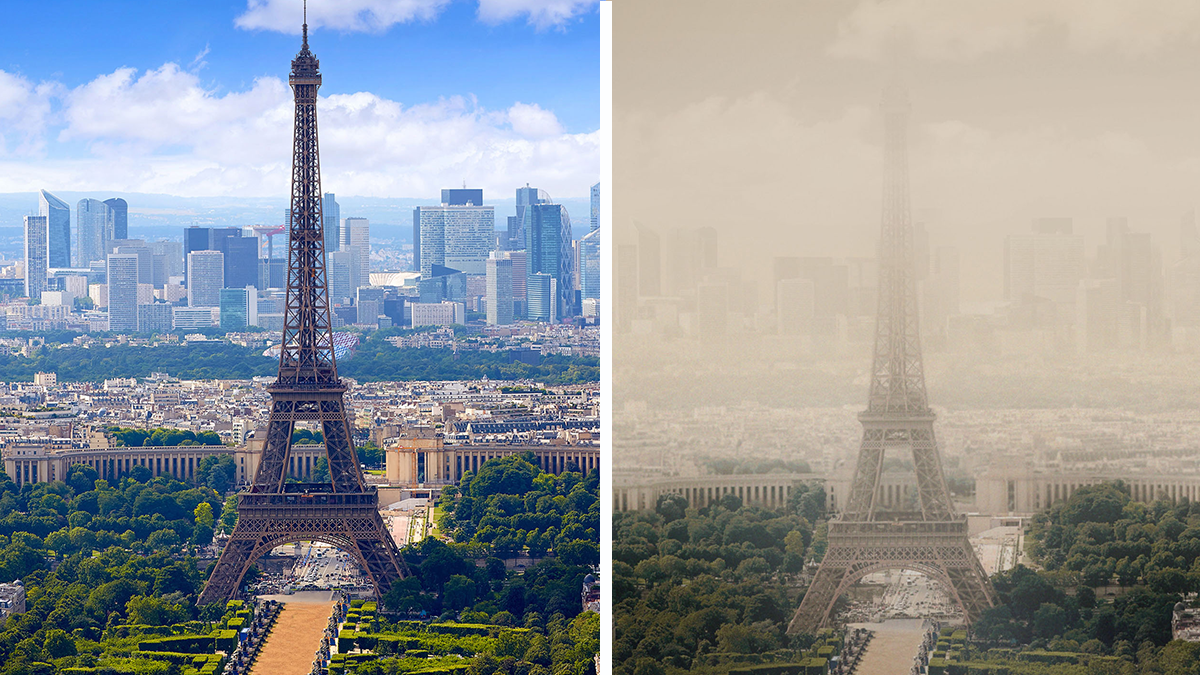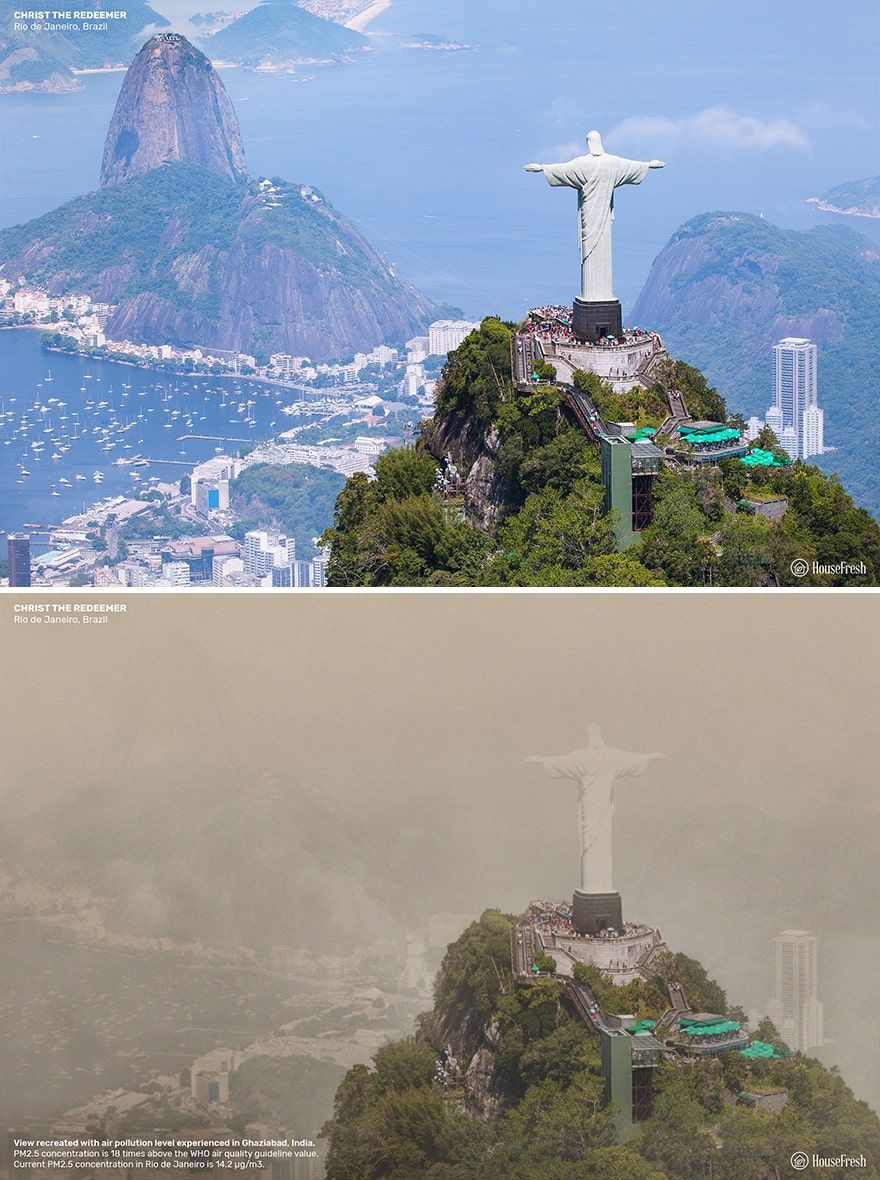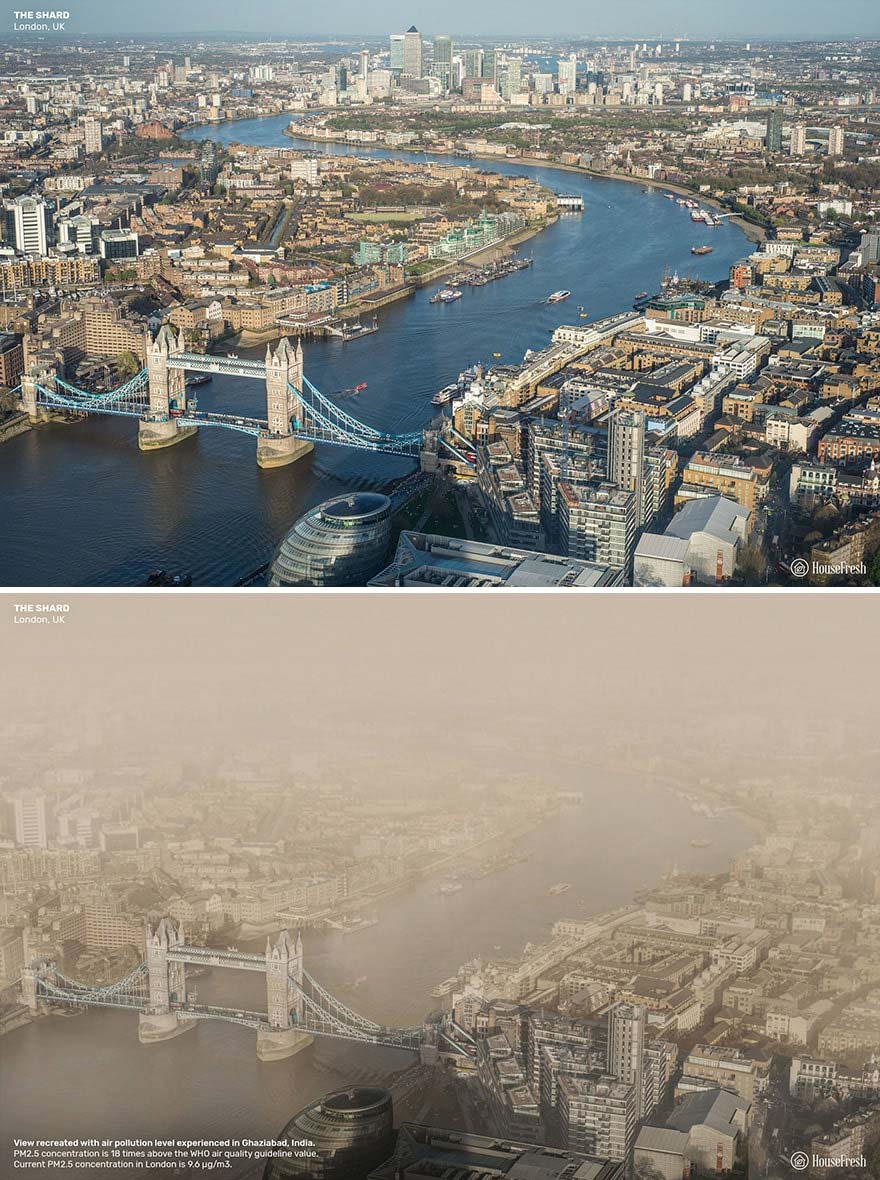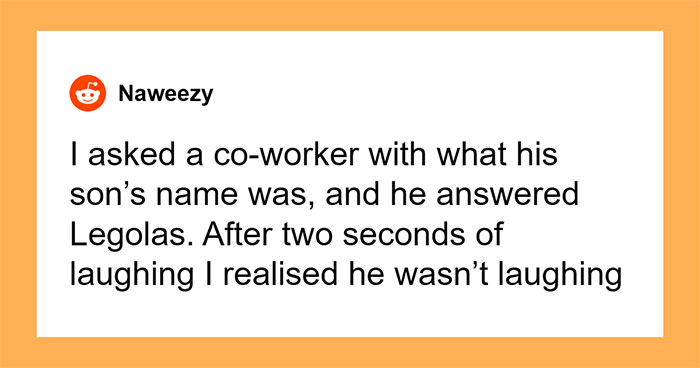
10 Of The World’s Most Beautiful City Views Ruined By Air Pollution: Study By HouseFresh
Despite decades of campaigning and policy change, air pollution is still worsening for more than half the world’s population. You might not notice the worsening effect in your daily, hometown life. But when you travel, the sight of industrial smog has a sobering effect.
As part of their mission to draw attention to the quality of the air you breathe, HouseFresh wanted to show you how 10 famous views could look if local human-made air pollution levels increase. The team found iconic photos of the views and, on each one, emulated the visual effect that air pollution has on the skyline of Ghaziabad, India, frequently ranked as the “most polluted city worldwide.”
More info: housefresh.com
This post may include affiliate links.
Rockefeller Center (New York, USA)
not real. if you read the print it said image was recreated. im from nyc and i can tell you...its never looked that way
Again, it says so in the description at the top of the page.
Load More Replies...HouseFresh curated a list of the most beautiful city views around the world, pulling examples from articles from Insider, RTE, and The Times. According to them, “when the first 2020 lockdown struck, a bonus was the drop in air pollution. The view through our windows seemed freshly polished. Tourist attractions shone with an intensity unseen for decades. Environmentalists keenly told us that this was a wake-up call, not a turning point”. However, this was only temporary.
Montparnasse Tower (Paris, France)
EVERYONE! BEFORE YOU GO THROUGH THIS POST, THESE PHOTOS ARE NOT REAL! IT SAYS IN THE DESCRIPTION THAT THIS IS JUST A MODEL OF WHAT FAMOUS LANDMARKS WOULD LOOK LIKE IF THEY HAD THE SAME AMOUNT OF POLLUTION AS GHAZIABAD, INDIA! THIS IS NOT A PRANK! IT SAYS WHAT IS HAPPENING IN THE DESCRIPTION!
Thank you so much Madeline! I thought I was going to be sad looking through this but not another thanks to you :)
Load More Replies...don't misunderstand, it is not really like that, it is a simulation
from a Parisian: this is a photograph of the Eiffel Tower taken from the Montparnasse Tower, with a simulation of the pollution of the city of Ghaziabad in India. Fortunately, our city is far from being so polluted: there are more and more bicycles, electric cars and old and excessively polluting vehicles are prohibited in Paris.
Last time i saw Montparnasse tower, it did not look like this at all.. Maybe be the Eiffel Tower instead ?
not real this is what it would it look like if it had the same air pollution of ghazibad india
Load More Replies...The pictures show how the views in each city might look if pollution levels reached that of Ghaziabad, India, the second most polluted city in the world. The most polluted city in the world is Hotan, China, which reports air pollution predominantly as a result of desert dust storms rather than man-made pollution, which is why the ream chose the second-most polluted city.
Kerry Park (Seattle, USA)
If you’re wondering how you could help in the fight against air pollution, there are a few simple ways that are adaptable to our everyday lives. You should reduce the number of trips using a car as well as the times you use a fireplace or woodstove. Also, avoid burning leaves, trash, and other materials, and using gas-powered lawn and garden equipment.
Christ The Redeemer (Rio De Janeiro, Brazil)
If you’re interested in learning more about the quarantine pollution drop, you can check out this post that includes 11 before-and-after comparisons showing the positive effect of the quarantine and how it was reducing pollution.
The Shard (London, UK)
all the pictures in this list are titled after the place from which the picture (with no fog or pollution) was taken, so the picture of the Eiffel Tower is titled "Montparnasse" because it was taken from the top of the Montparnasse tower, and this picture was taken from the Shard, herego its title
Load More Replies...Although I would argue that London at some point in histoy did look like this. And I don't mean the infamous natural fog of the city.
Mrs. Macquarie’s Point (Australia)
St. Peter’s Basilica (Rome/Vatican City, Italy)
It's not a prank.It says it in all of the 2nd pictures. "View Recreated with air pollution level experienced in Ghaziabad, India".
Load More Replies...Centre Island (Toronto, Canada)
Tokyo Skytree (Japan)
Victoria Peak (Hong Kong)
"View recreated with air pollution level experienced in Ghaziabad, India." Caption on every photo.
Load More Replies...I feel bad for the people in India that have to live with that level of pollution. But these other cities must have implemented restrictions so that their cities don't end up with pollution like that. Time to put the pressure on the Indian Government to fix it. Let's clean up the world, not lower everyone else.
You are asking for a developing nation to make infrastructure. Do you think normal people in India can afford EVs and charging stations. Putting pressure won't do a thing because the products made by countries like China and India are not even used by them. The ones who are using them are the same ones who lecture them.
Load More Replies...When I was about 13, in 1973, my parents and I went on a trip to NYC. I actually still have the picture I took of the Statue of Liberty shrouded in a kind of brownish-gray smog. That smog, which smelled as bad as it looked, is the one memory of that trip that has stayed with me for almost 50 years. Then, in 1974, we moved to Los Angeles, where the local morning news would give the smog report, and list who could go outside (generally children and old folks) and who should not. I remember PE classes having to be held inside instead of outside on those days. That was back when cars still ran on leaded gas too. That means my generation, and the generations before that breathed while cars spewed lead in their exhaust, have traces of lead in our lungs that post-catalytic converter generations won’t. We’ve done a good job of cleaning our air, but it’s been a drop in the bucket compared to what we actually have to do—-and should’ve started doing long before my 1973 trip to NYC.
i don't think a view full of steel and concrete is anything worth looking at anyway, so the fogginess is an improvement, though not really for lung health. But there are probably people who would say a view of nothing but a bunch of mile high rocks and trees is nothing worth looking at so.. whatever.
not real this is what it would it look like if it had the same air pollution of ghazibad india
Load More Replies...I really hope the whole world doesn't come to this. Even seeing these simulations is making me a little depressed..
not real this is what it would it look like if it had the same air pollution of ghazibad india
Load More Replies..."View recreated with air pollution level experienced in Ghaziabad, India." Caption on every photo.
Load More Replies...I feel bad for the people in India that have to live with that level of pollution. But these other cities must have implemented restrictions so that their cities don't end up with pollution like that. Time to put the pressure on the Indian Government to fix it. Let's clean up the world, not lower everyone else.
You are asking for a developing nation to make infrastructure. Do you think normal people in India can afford EVs and charging stations. Putting pressure won't do a thing because the products made by countries like China and India are not even used by them. The ones who are using them are the same ones who lecture them.
Load More Replies...When I was about 13, in 1973, my parents and I went on a trip to NYC. I actually still have the picture I took of the Statue of Liberty shrouded in a kind of brownish-gray smog. That smog, which smelled as bad as it looked, is the one memory of that trip that has stayed with me for almost 50 years. Then, in 1974, we moved to Los Angeles, where the local morning news would give the smog report, and list who could go outside (generally children and old folks) and who should not. I remember PE classes having to be held inside instead of outside on those days. That was back when cars still ran on leaded gas too. That means my generation, and the generations before that breathed while cars spewed lead in their exhaust, have traces of lead in our lungs that post-catalytic converter generations won’t. We’ve done a good job of cleaning our air, but it’s been a drop in the bucket compared to what we actually have to do—-and should’ve started doing long before my 1973 trip to NYC.
i don't think a view full of steel and concrete is anything worth looking at anyway, so the fogginess is an improvement, though not really for lung health. But there are probably people who would say a view of nothing but a bunch of mile high rocks and trees is nothing worth looking at so.. whatever.
not real this is what it would it look like if it had the same air pollution of ghazibad india
Load More Replies...I really hope the whole world doesn't come to this. Even seeing these simulations is making me a little depressed..
not real this is what it would it look like if it had the same air pollution of ghazibad india
Load More Replies...
 Dark Mode
Dark Mode 

 No fees, cancel anytime
No fees, cancel anytime 

































































